Want to grow plants without worrying about soil quality? And save water in the process? Aeroponics could be just what you need.
Read on to find out more about this alternative to conventional agriculture and explore different aeroponic systems.
Aeroponics Definition
Aeroponics is the process of growing plants in a humid, misty environment without soil or another grow medium.
It’s a development of hydroponics that has been in use for decades. Technically, it’s more advanced than most hydroponics systems.
“Aeroponic” comes from Greek, from the words aer (air) and ponos (labor). It’s is one of the least labor-intensive ways to grow plants, as you will see.
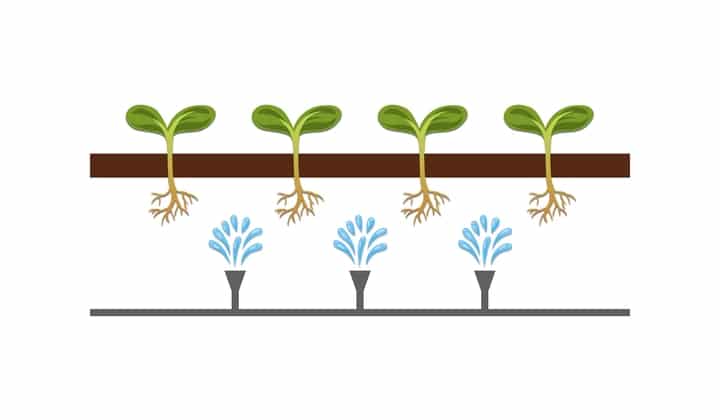
How Does an Aeroponic System Work?
An aeroponic system delivers nutrients straight to the roots of the plant. It doesn’t use any grow medium to keep the plant in place. Instead, the roots stay suspended in the air.
Sounds a bit strange? It’s not at all! Here’s are the basic principles explained.
- With aeroponics, you insert the plants into a platform with holes in it or net pots.
- Support collars hold the stems in place while leaving the roots enough room to grow.
- The platform sits on top of a reservoir with water and nutrients.
- Sprinklers connected to a water pump spray vapor over the roots at regular intervals.
- The vapor carries a precise amount of nutrients, water, and growth hormones.
- A timer regulates the spray intervals and their duration.
- The plant absorbs the nutrient spray and oxygen.
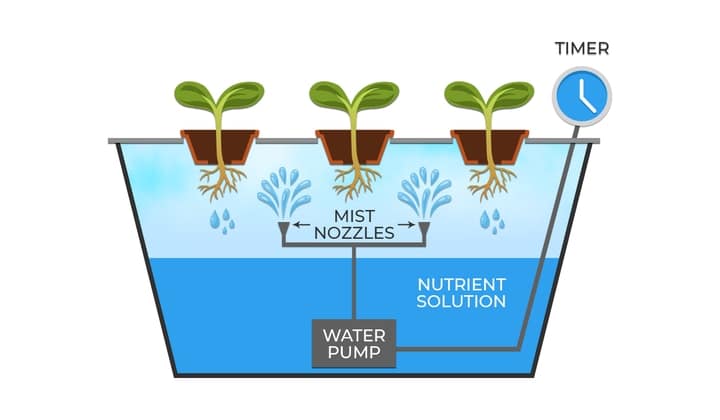
Good to know: Because the roots don’t sit in soil nor are they submerged in water, they get more oxygen than in a hydroponic system. The result? Better root oxygenation speeds up plant growth.
Aeroponics vs Hydroponics
Technically speaking, aeroponics is a type of hydroponics, which is why they’re often bunched together. But there are a few key differences between an aeroponic system and a hydroponic one. Discover them now.
Setup
Both systems use a pump and a reservoir and may also use a timer. That makes them look similar at a first glance.
But aeroponics secures the plants while leaving their roots exposed to the air. For this, it uses net pots or boards with slats or holes in them. In an aeroponics setup, the roots are never submerged.
Nutrient Delivery
With aeroponics, the roots of the plants grow in a nutrient-rich mist. A pump working on a timer mists the roots at regular intervals.
By contrast, in a hydroponic system, the roots stay in the water or another grow medium. Aeroponics creates a humid, fog-like growth environment rather than a wet one.
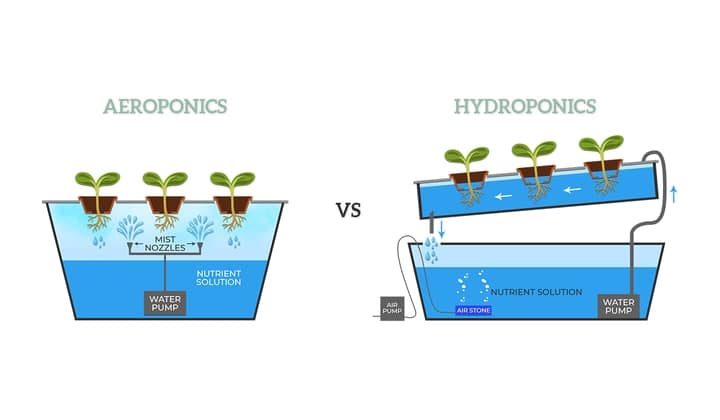
Efficiency of hydroponics systems
The mist flow of an aeroponic system can lead to fluctuating levels of nutrients and pH in the water. It’s not a tragedy. But it does calls for more frequent testing than with a hydroponics system.
On the other hand, it requires less water to deliver nutrients to the plant. When properly set up, aeroponics is more water-efficient than hydroponics.
Also, because aeroponics exposes the plant to more oxygen, it promote faster growth.
Cycles
Hydroponics systems have longer water and nutrient cycles. Aeroponics systems, on the other hand, mist the plants more often to prevent the roots from becoming dry.
This means that aeroponics needs to operate on a precise timer to enable healthy plant development. If the timer fails, well, that’s bad!
So, what’s the bottom line in this comparison?
The Bottom Line: Aeroponic systems can be more energy-efficient than hydroponics but require more technical expertise. If they’re not properly calibrated, they don’t deliver.
Types of Aeroponics Systems
Aeroponic systems can operate at low or high pressure. This is what differentiates basic setups from advanced ones. Let’s take a closer look at the different setups you can use.
Low Pressure Aeroponics (LPA)
Most beginners start with a low pressure aeroponics system. This system uses a pump, sprinklers, a reservoir, and a platform for the plants with an enclosed root chamber.
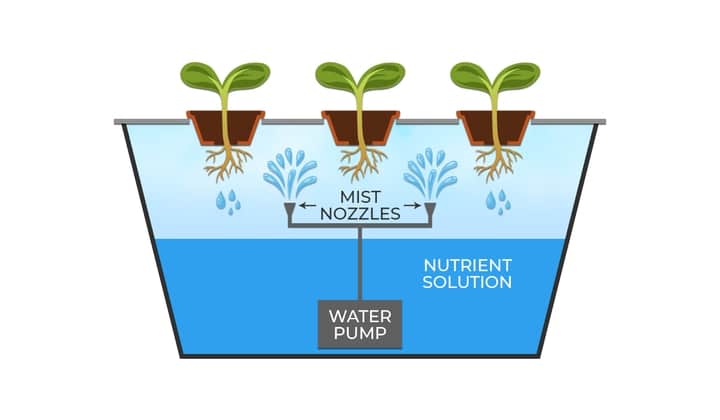
This system creates water droplets over 50 microns in size. That’s about the diameter of a human hair.
LPA setups are relatively easy to install up and can handle most varieties of plants. You’ll find them in most hydroponic shops at good prices.
All things considered, LPA is a safe choice if you’re just getting started.
Pros
- Easy to set up and use
- Most affordable aeroponic system
Cons
- For small scale use only
- May not be powerful enough for plants requiring lots of nutrients
High Pressure Aeroponics (HPA)
High pressure aeroponics atomizes water below 50 microns. The very small droplet size creates more oxygen for the root zone. This improves nutrient delivery and speeds up plant growth.
HPA systems require a powerful pump and specialized sprinklers. What’s more, you have to set them up properly for them to work efficiently. Commercial aeroponics users usually opt for this system.
Pros
- Improves root oxygenation
- Delivers nutrients efficiently
Cons
- Requires some technical knowledge
- Can be expensive to set up
Ultrasonic Fogger Aeroponics (Fogponics)
Ultrasonic fogger aeroponics (fogponics) atomizes water below 5 microns so that they appear as fog. That’s way below the visibility threshold. It’s smaller even than a red blood cell.
Because they are so small, the droplets are less likely to hurt even young and sensitive roots. No surprise then that fogponics is great for seedlings, clonings, and herbs.
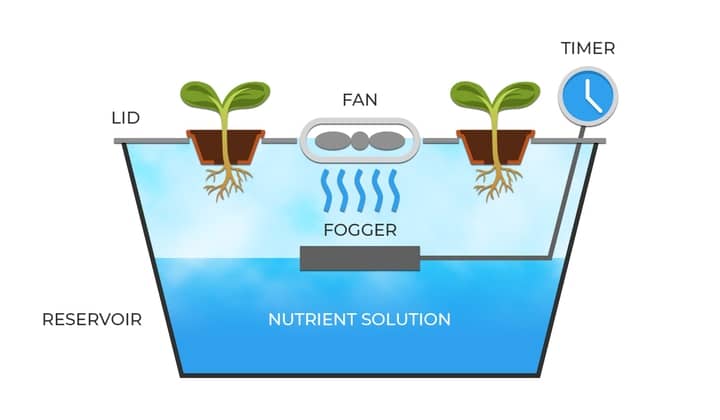
In theory, the smaller the droplets, the easier it is for the plants to absorb water. However, fogponics requires expensive equipment.
Also, it calls for careful maintenance to ensure the high-pressure pump operates optimally. Fogponics also requires more declogging.
Pros
- Great coverage for the plant roots
- Makes aeroponics cloning easy
- High nutrient concentration
Cons
- Buildup of salt requires constant cleaning
- Atomizer can heat the reservoir
- Susceptible to power outages
What Can You Grow with Aeroponics?
In theory, you can grow almost any plant. In practice, though, it’s important to remember that different plants have different nutrient requirements. Also, not all plants prefer growing in moist conditions.
Seedlings
Aeroponics is great for growing seedlings. Why? Because these have fragile roots that hydroponic or aquaponic systems may damage. Aeroponic systems mist the roots gently, causing no damage.
Clonings
Clonings don’t have a developed root system. That makes it challenging to provide them with nutrients.
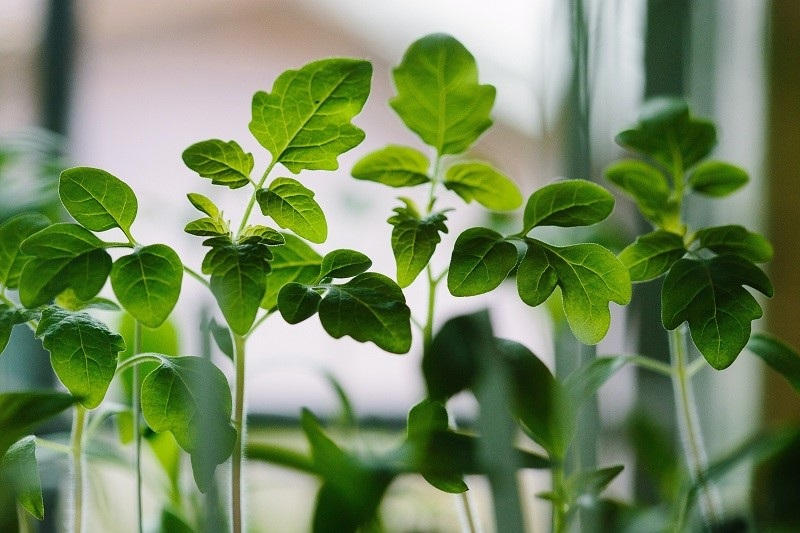
Cloning with aeroponics is easy because the small droplet size provides nourishment to the roots without damaging them.
Herbs
Herbs grow faster than vegetables or flowers while usually requiring fewer nutrients. That means herbs thrive in aeroponics systems. The best herbs for aeroponics include basil, mint, and chives.
Vegetables
Aeroponics works best with green vegetables. But you can also grow other vegs. Here’s a list of vegetables you can grow:
- Lettuce
- Kale
- Spinach
- Cucumber
- Eggplant
- Tomato
Fruits
Can you grow fruits aeroponically? Yes, you can. Here are some ideas:
- Strawberries
- Watermelon
- Pear
- Plum
Flowers
As a general rule, you can use aeroponics to grow annual flowers but not perennials. That’s because perennials require beneficial bacteria and fungi only found in the soil.
- Carnation
- Roses
- Orchid
- Zonal geraniums
In the end, what you can grow with aeroponics depends on your setup, the nutrients you use, and how carefully you optimize your system.
The Best Aeroponics Systems
The quickest way to get started with aeroponics is to buy a ready-made system. LPA setups work with most plants and have low running costs.
When choosing the design, consider how much space you got for it. Tower aeroponics systems, for example, take advantage of vertical space to increase the grow area.
Discover some of the best aeroponic systems around with in-depth reviews and key features.
TurboKlone T24D Cloning System
Cloning with aeroponics is an efficient process. Even if you don’t plan to grow many plants, you may still want to give this type of cloning a try. This setup doesn’t require much space so perfect for small homes.
The rounded design makes cleaning easy, too. Also, it includes a fan to keep the system cool and prevent it from increasing the temperature of the water.
Key features
- Compact design with 24 plant sites
- Fan and shroud prevent overheating during continuous operation
- Humidity protection
Psycloner Pro Aeroponic Cloner Machine
With room for 140 plants, this aeroponics cloner is a hassle-free choice for large-scale home cloning. It uses the basic principles of aeroponics to create a stable and reliable system.
The colorful plant sites make it easy to keep different types of plants separated. You’ll find in the box a germination kit that comes in handy.
Another plus is the foldable humidity dome for preventing transplant shock. Also, the system is pretty easy to take apart and clean.
Key features
- 140 plant sites
- Cutting and rooting germination kit
- Foldable humidity dome
Aerospring Indoor Aeroponic System
Don’t let the “hydroponic” in the name deceive you. This is a vertical aeroponic tower garden perfect for growing herbs, leafy greens, and veggies.
Tower aeroponics save space. They can fit in just about any house, including apartments. This system is a good example.
The 10 square feet growing space accommodates up to 27 plants. If you’re growing vets, that could mean up to three servings a day. Not bad right?
Built-in lights, tent covers for speeding up growth, and the cool design add to its appeal.
Key features
- Compact vertical design
- Tent wraps for faster growth
- Airflow management
Aerospring Vertical Herb & Vegetable Garden
This compact aeroponics tower garden from the same brand was designed for outdoor use. You can use it to grow up to 27 plants on a balcony, terrace, patio, or sheltered space in your garden.
But keep in mind that it doesn’t come with a light source. That means you got to place it in a space where your plants get enough sun.
Also, don’t forget that different plants may have different light requirements. Optimize exposure to the sun by placing the plants who need it the most on top.
Key features
- Mobile app integration for controlling light and irrigation
- Built-in LED grow lights
- Works outdoors
DIY Aeroponic Systems
Any of the systems above are great to start with. But you can also make your DIY aeroponics system.
That way you can customize it to your specific needs. You can do aeroponics farming your way.
Here are some tutorials to get you started.
Low Pressure Two Bucket Aeroponic System
If you want to start small and keep things simple, this DIY aeroponics project could be just right for you. Key components include two 5-gallon buckets, misting nozzles, and PVC spray bars.
Chances are you may already have some of these items in your garage. Follow the instructions in this video by Peter Stanley to get it up and running. It won’t take long!
Low Pressure Aeroponics Cloning Tote Box
You can also build your own aeroponics cloning system with plenty of plant sites. You’ll be needing a 27-gallon construction-grade storage container, pipes and fittings, and sprayers.
Here’s how to do it—the whole thing should be ready in an hour or two.
Automate Aeroponics Garden
If you got time to spare, you can build a DIY aeroponics garden with an ultrasonic fogger. Watch these smart teens explain the principles of the system.
This system is very adaptable. You can modify it to make the best use of your space and increase or lower plant sites as needed.
Aeroponics FAQs
Every week we get tons of readers questions on hydro-, aqua-, and aeroponics systems, that’s why we decided to post the most common questions on these systems here.
Is aeroponics better than hydroponics?
Aeroponics requires less water than hydroponics. But then you have to test water pH and nutrient levels more often. Also, aeroponics systems usually require a higher level of technical knowledge.
What are the disadvantages of aeroponics?
Aeroponics requires a solid understanding of plant nutrient needs. Another potential drawback is the cost. But you can balance these in time by thanks to lower operational costs.
What are the benefits of aeroponics?
The key benefits of aeroponics are the efficient use of water and energy, faster plant growth, fewer maintenance requirements, easy cleaning, disease-free plant growth, and human labor reduction.
Is aeroponics expensive?
An aeroponic system can cost hundreds of dollars. But while aeroponics is not cheap, you have to consider its long-term benefits. These include faster growth and efficient energy use.
Getting your Ponics on!
Aeroponics is not just about growing some plants faster. It’s a way of understanding what plants need to thrive and using that knowledge to create optimal conditions for them.
Also, it’s about using space efficiently, saving water, and reducing manual labor.
You don’t even have to do large-scale aeroponics farming to reap the rewards.
A small aeroponics system for the home captures the beauty and efficiency of this practice. In the end, growing plants aeroponically is a way to live a greener, healthier life.
So, what are you waiting for? Get started now!

Leave a Reply